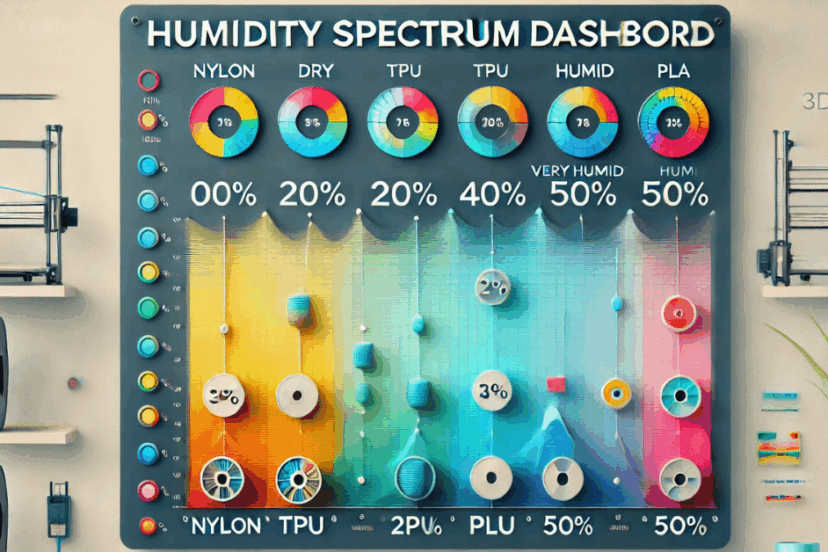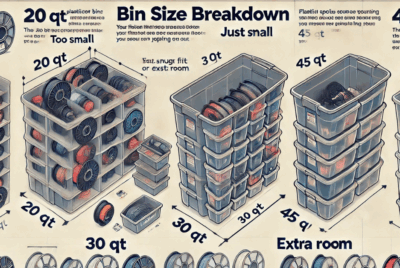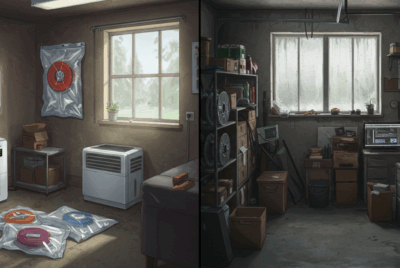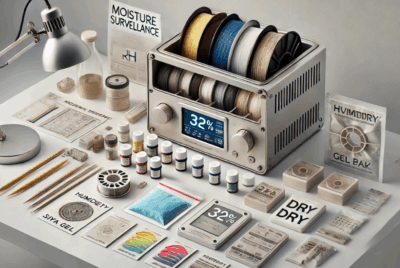What is the Ideal Humidity Level for Storing Vacuum-Sealed Filament?
Maintaining the correct humidity level is essential for preserving the quality of 3D filament during storage. Moisture-sensitive filaments, like Nylon, TPU, and ABS, can degrade quickly when exposed to high humidity, resulting in poor print quality, bubbling, and adherence issues. Vacuum-sealing offers excellent protection, but knowing the ideal humidity level to store filament in can help ensure that it remains dry and ready to use.
1. Understanding the Role of Humidity in Filament Storage
- What It Means:
- Humidity refers to the amount of moisture in the air, and it can significantly impact the properties of filament. When filament absorbs moisture, it can cause issues like cracking, bubbling, or uneven extrusion during printing.
- Why It Matters:
- Filament types such as Nylon and TPU are highly sensitive to moisture. Exposure to humidity can weaken the filament, making it difficult to print with, leading to defects such as stringing or poor layer adhesion. Therefore, controlling the humidity level in storage is critical for maintaining filament quality.
- How to Do It:
- To ensure optimal filament storage, the vacuum-sealed bag should maintain a low moisture level. When stored in a dry, controlled environment, the filament is less likely to absorb moisture from the air, preserving its physical properties and printability.
2. Ideal Humidity Levels for Different Filament Types
- What It Means:
- Different filaments have different moisture sensitivity thresholds. Some filaments can tolerate slightly higher humidity levels, while others require very low humidity to maintain their best quality.
- Why It Matters:
- Knowing the ideal humidity level for each filament type will help you tailor your storage conditions for maximum filament longevity.
- How to Do It:
- PLA: While PLA is not as moisture-sensitive as other filaments, it still performs better when stored in a dry environment. Ideal humidity for PLA is around 20%-50%.
- Nylon: Nylon is extremely moisture-sensitive, and even a small amount of moisture can cause issues. The ideal humidity for Nylon is below 20%.
- TPU: Similar to Nylon, TPU is also sensitive to moisture and should be stored at 20%-40% humidity.
- ABS: ABS can absorb moisture and cause bubbling when printed, so it’s best stored at a humidity level around 30%-50%.
- PETG: PETG is less sensitive to moisture than Nylon and TPU but still performs best when stored at below 40% humidity.
3. Ideal Humidity Range for General Filament Storage
- What It Means:
- For most 3D printing filaments, the ideal storage humidity level falls within a certain range that minimizes moisture absorption while maintaining filament quality.
- Why It Matters:
- Keeping filament in a controlled humidity environment ensures that the material remains in optimal condition for printing, preventing degradation and reducing the need for re-drying.
- How to Do It:
- The ideal range for most 3D printing filaments is between 20%-40% relative humidity (RH). This low level of moisture keeps the filament dry without being overly dry, which could lead to brittleness in some materials.
- Desiccants, such as silica gel, inside the vacuum-sealed bag can help maintain this ideal humidity level by absorbing excess moisture. You may also want to use humidity sensors to monitor the conditions inside the storage area or bags.
4. Importance of Maintaining a Consistent Humidity Level
- What It Means:
- Fluctuating humidity levels can cause filament to absorb moisture at different rates, leading to inconsistent quality. A consistent, low humidity environment ensures that the filament stays stable and high-quality throughout its storage period.
- Why It Matters:
- Humidity fluctuations can cause filament to expand and contract, leading to physical deformities or inconsistent extrusion when printed. Maintaining a stable environment helps ensure that the filament performs as expected during printing.
- How to Do It:
- Store filament in a cool, dry place with minimal temperature and humidity fluctuations. Using airtight containers, dry boxes, or vacuum-sealed bags equipped with desiccants can help maintain a stable humidity level for extended periods.
- Benefit:
- Maintaining consistent humidity levels improves print quality and reduces filament wastage, especially for high-performance or moisture-sensitive filaments.
5. Using Desiccants for Moisture Control
- What It Means:
- Desiccants, such as silica gel or molecular sieve, are commonly used in vacuum-sealed bags to absorb any residual moisture that may be present inside the bag.
- Why It Matters:
- Desiccants are essential for keeping the moisture level inside the vacuum-sealed bag consistently low. Without desiccants, the vacuum bag may not be able to maintain an ideal humidity level over time.
- How to Do It:
- Add silica gel packs or rechargeable desiccants inside the vacuum-sealed bag. For larger filament spools or multiple spools, you may need to use multiple desiccant packs to ensure the entire bag stays dry.
- Ensure that the desiccant is large enough to handle the moisture content inside the bag and replace or recharge it when needed.
- Benefit:
- Desiccants help maintain an optimal humidity level and prevent moisture buildup, ensuring that the filament remains dry and in perfect condition for printing.
6. Impact of Humidity on Filament Performance
- What It Means:
- The humidity level has a direct impact on filament quality, especially when it comes to moisture-sensitive materials. High humidity can cause the filament to absorb water, which leads to print defects, weak adhesion, bubbling, and poor extrusion.
- Why It Matters:
- Moisture contamination can drastically affect the quality of your prints. For materials like Nylon and TPU, excessive moisture can cause the filament to degrade, making it brittle, sticky, or difficult to extrude.
- How to Do It:
- Keep the filament in a dry environment where the humidity level stays consistently within the 20%-40% range. This will ensure that the filament stays moisture-free and ready to use.
- Benefit:
- Proper humidity control prevents print failures, inconsistent extrusion, and helps maintain the structural integrity of the filament.
Summary of Ideal Humidity Levels for Filament Storage:
| Filament Type | Ideal Humidity Level |
|---|---|
| PLA | 20%-50% RH |
| Nylon | Below 20% RH |
| TPU | 20%-40% RH |
| ABS | 30%-50% RH |
| PETG | Below 40% RH |
Conclusion:
Maintaining the ideal humidity level for storing vacuum-sealed filament is crucial to preserving its quality and ensuring successful prints. For most filaments, a humidity level of 20%-40% RH is ideal. Filaments like Nylon and TPU are particularly moisture-sensitive and require storage at even lower humidity levels, ideally below 20%. By using vacuum-sealing in conjunction with desiccants, you can maintain the necessary humidity levels to keep your filament in optimal condition. Regularly monitor the humidity levels, especially in humid environments, to ensure that your filament stays dry and ready for use.




